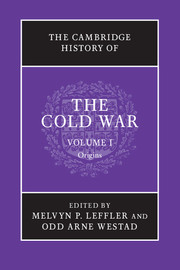Book contents
- Frontmatter
- 1 The Cold War and the international history of the twentieth century
- 2 Ideology and the origins of the Cold War, 1917–1962
- 3 The world economy and the Cold War in the middle of the twentieth century
- 4 The emergence of an American grand strategy, 1945–1952
- 5 The Soviet Union and the world, 1944–1953
- 6 Britain and the Cold War, 1945–1955
- 7 The division of Germany, 1945–1949
- 8 The Marshall Plan and the creation of the West
- 9 The Sovietization of Eastern Europe, 1944–1953
- 10 The Cold War in the Balkans, 1945–1956
- 11 The birth of the People’s Republic of China and the road to the Korean War
- 12 Japan, the United States, and the Cold War, 1945–1960
- 13 The Korean War
- 14 US national security policy from Eisenhower to Kennedy
- 15 Soviet foreign policy, 1953–1962
- 16 East Central Europe, 1953–1956
- 17 The Sino-Soviet alliance and the Cold War in Asia, 1954–1962
- 18 Nuclear weapons and the escalation of the Cold War, 1945–1962
- 19 Culture and the Cold War in Europe
- 20 Cold War mobilization and domestic politics: the United States
- 21 Cold War mobilisation and domestic politics: the Soviet Union
- 22 Decolonization, the global South, and the Cold War, 1919–1962
- 23 Oil, resources, and the Cold War, 1945–1962
- Bibliographical essay
- Index
- References
13 - The Korean War
Published online by Cambridge University Press: 28 September 2010
- Frontmatter
- 1 The Cold War and the international history of the twentieth century
- 2 Ideology and the origins of the Cold War, 1917–1962
- 3 The world economy and the Cold War in the middle of the twentieth century
- 4 The emergence of an American grand strategy, 1945–1952
- 5 The Soviet Union and the world, 1944–1953
- 6 Britain and the Cold War, 1945–1955
- 7 The division of Germany, 1945–1949
- 8 The Marshall Plan and the creation of the West
- 9 The Sovietization of Eastern Europe, 1944–1953
- 10 The Cold War in the Balkans, 1945–1956
- 11 The birth of the People’s Republic of China and the road to the Korean War
- 12 Japan, the United States, and the Cold War, 1945–1960
- 13 The Korean War
- 14 US national security policy from Eisenhower to Kennedy
- 15 Soviet foreign policy, 1953–1962
- 16 East Central Europe, 1953–1956
- 17 The Sino-Soviet alliance and the Cold War in Asia, 1954–1962
- 18 Nuclear weapons and the escalation of the Cold War, 1945–1962
- 19 Culture and the Cold War in Europe
- 20 Cold War mobilization and domestic politics: the United States
- 21 Cold War mobilisation and domestic politics: the Soviet Union
- 22 Decolonization, the global South, and the Cold War, 1919–1962
- 23 Oil, resources, and the Cold War, 1945–1962
- Bibliographical essay
- Index
- References
Summary
The Korean War was a seminal event of the early Cold War, both regionally and globally, and of Korean history. The conflict militarized international politics far beyond previous levels, but, in part due to the better-defined superpower commitments that emerged in Europe and Northeast Asia, it also produced a relatively stable military balance, making less likely a direct confrontation between the United States and the Soviet Union. On the other hand, the war solidified China’s division, escalated American involvement in Indochina, and ensured the prolonged estrangement of the United States and the People’s Republic of China. Those developments, in turn, increased the likelihood of future conflict in Southeast Asia. For the short term, the war tightened the Sino-Soviet alliance, but it also sowed the seeds of future animosity between the Communist giants. Finally, while the fighting during the war did not extend beyond Korea’s boundaries, it led to massive destruction on the peninsula and deepened the country’s division.
Origins
The war emerged from an array of Korean and international factors. During the century prior to the outbreak of war on 25 June 1950, Korea was rent by division and foreign encroachment. Contending indigenous groups usually derived their identity from a combination of internal forces and ties to foreign powers. When in the 1880s Korea opened its gates to the Western world, pro-Chinese, pro-Japanese, pro-Russian, and pro-American factions all emerged, each drawing on the ideas and/or maneuvers of the great powers. Internal turmoil joined with the ambitions of more powerful neighbors to produce two major regional conflicts between 1894 and 1905. Japan emerged victorious in both, annexing the peninsula in 1910. Korean activists seeking to end foreign rule looked to other nations for inspiration and support. With the rise of Marxism-Leninism in Russia in 1917 and the emergence of the struggle between Nationalists and Communists in China in the 1920s, Korean exiles inevitably took sides, with traditionalists of a Confucian stripe looking to the Nationalist Chinese, liberals of a capitalist, democratic bent appealing to the United States, and radicals casting their eyes toward the Soviet Union and/or the Communist Chinese. Affiliations were also influenced by regional or family origin in Korea and a foreign power’s or party’s geographic proximity to the peninsula, or hopes of their assistance against the Japanese.
- Type
- Chapter
- Information
- The Cambridge History of the Cold War , pp. 266 - 287Publisher: Cambridge University PressPrint publication year: 2010
References
- 2
- Cited by



